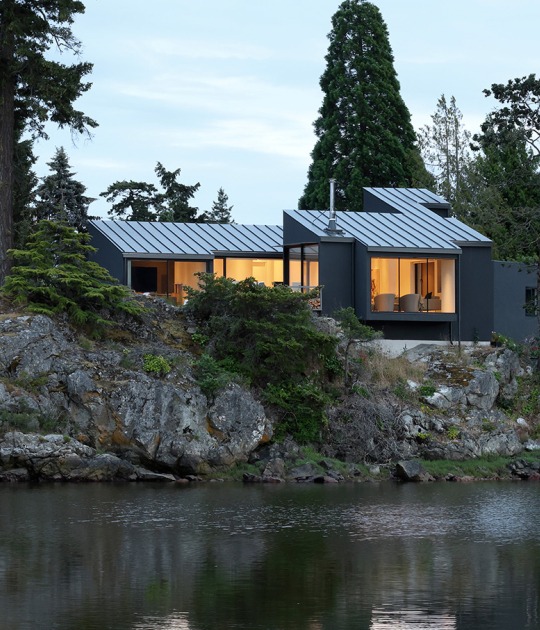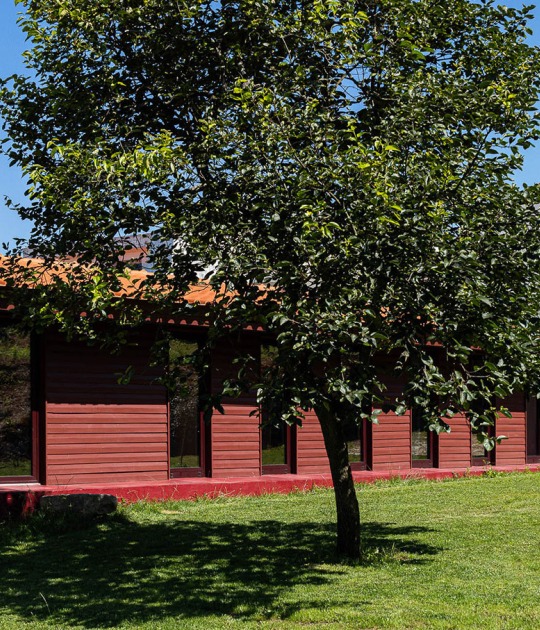The new building leaves a space to the south between the wall and the garden, and given the program it hosts, it does not have direct views towards or from the public space, using the notion of patio and introverted space that looks towards the garden, towards nature, which also inspired the choice of bio-based materials, raw earth and wood.
Earth is a qualitative and virtuous material that, of course, makes it possible to build, but above all it offers the possibility of embodying a truly sustainable relationship with the world and with the plot. As for wood, its qualities no longer need to be tested. It is a renewable resource that consumes little energy for its production and industrial transformation while contributing to the reduction of the greenhouse effect.

Child care centre in wood and rammed earth by Régis Roudil. Photograph by Florent Michel - 11h45.
Project description by Atelier Régis Roudil Architectes
In this monumental and powerful context, withdrawn and away from the urban hustle and bustle, the Presidency of the Republic decided to programme the construction of a nursery. Previously housed in an older, ill-adapted building on the rue de l’Elysée, its new position provides it with a genuine place of serenity. In the heart of the Palais de l’Alma, Napoleon’s former stables, the south garden allows the silence to resonate in welcoming this new facility.
Nearby monuments, notably the Eiffel Tower and the Musée du Quai Branly, although very different in their composition, each day tell us a story of the history of Paris. One of the challenges of this project was to carefully integrate it into this exceptional urban fabric in a way that respected the existing built heritage. But also, to stand alongside the qualities of a peaceful place where greenery dominates and to reveal its thick contours.
Inside the Palais de l’Alma, if the three courtyards, the central axis and the rational composition of the built volumes enable us to plunge into symmetrical architecture, the garden alone appears as a bucolic green lung in this stone context. Delimited to the south and the west by two perimeter walls, the project’s site subtly extends the south garden towards the one of the Musée du Quai Branly, designed by Gilles Clément. Together, they form a coherent green whole.
 Child care centre in wood and rammed earth by Régis Roudil. Photograph by Florent Michel - 11h45.
Child care centre in wood and rammed earth by Régis Roudil. Photograph by Florent Michel - 11h45.

Child care centre in wood and rammed earth by Régis Roudil. Photograph by Florent Michel - 11h45.
The volume of the child care centre and its exterior space extend from the perimeter wall all the way to the merry-go-round. To anchor the building to the site, a space is left to the south side between the wall and the garden and the nursery to allow access for security to make the rounds of the entire site. As this place is sensitive, owing to its purpose and its function, it has no direct views onto or from the public space. The notion of courtyard and introverted space is evoked. On the north side, the children’s garden is placed in direct contact with one of the Palais to offer users the enjoyment of a visual escape towards nature.
Our design, strengthened by this intimate relationship with nature, led us to imbue the elements with a telluric meaning, which naturally inspired the choice of bio-sourced materials. Both with the aim of respecting the client’s ambitious goals for the environment but also to anchor the project in a way that resonates with the materials of the garden. In this sense, the nursery is comprised of raw earth and wood.
Concerning the material of earth, this project makes it possible to envisage this resource, no longer as a simple excavation but rather as a construction material. Earth is a qualitative and virtuous material that of course makes it possible to build, but that especially offers the possibility of embodying a genuinely sustainable relationship with the world and savings that are resolutely anchored in its plot of land. As for wood, its qualities no longer need to be proven. It is a renewable resource that consumes little energy for its production and industrial transformation whilst also contributing to the reduction of greenhouse effect.










































